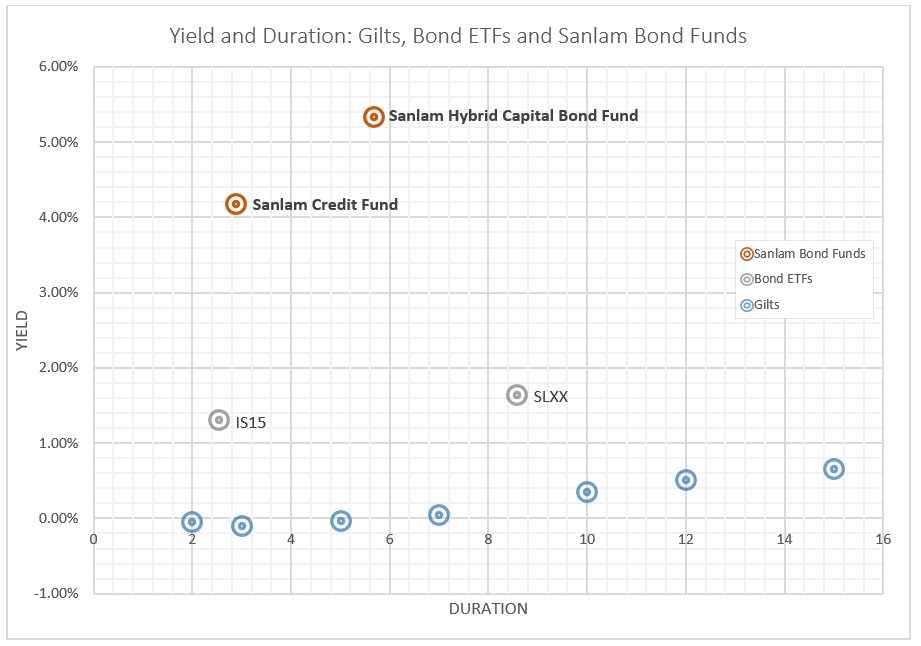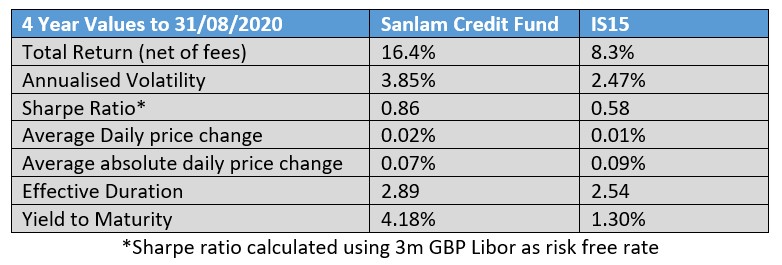Key takeaways
-
Many adviser portfolios are underweight fixed income. Cash, Gilts and Investment Grade corporate bonds could cause a drag on portfolio returns as yields go up, but do offer a degree of nominal capital protection for long term holders
-
On the positive side, other parts of the active £ fixed income market still yield enough to deliver secure positive real returns over the medium term for patient investors, even in the event of a modest rise in interest rates
-
Look at the break-even rate over one, two and three years to work out where to invest
Being underweight fixed income
As the saying goes when buying a bike, “Cheap, Light, Strong - Pick any two”. For many people looking at bonds, the choice appears to be, “Real Yield, Sensible Duration, Creditworthy - Pick any two”.
Many advisers are underweight cash, Gilts and traditional corporate bonds on the basis that the net income is very low in nominal terms, and negative in real terms.
Over the past five years, 10-year Gilt yields have averaged 1.1% (currently 0.25 %) and UK CPI – a measure of inflation – has averaged 1.5% (currently 1.0%). For some, these numbers epitomise what has been termed “return free risk”.
The chart below shows duration versus yield for various Gilts, two £ corporate bond ETFs – iShares £ Corp Bond 0-5yr UCITS ETF (IS15) and iShares Core £ Corp Bond UCITS ETF (SLXX) – and the two Sanlam long-only bond funds – Sanlam Credit Fund and Sanlam Hybrid Capital Bond Fund.

Past performance is not a guide to future performance
What does this mean for future returns?
SLXX currently has a yield of 1.64% with a duration of 8.58 years offering very little protection against higher future yields. A 100 bps increase in yield on SLXX will cause a price fall of circa 8.6% which would take more than three years to make back from yields.
If medium to long duration high corporate bond yields head back to around only 2.5%, then SLXX LN will deliver a negative return over at least three years - before any other fees.
How to plan for the future?
Consider investing in bond funds with a relatively high yield per unit of duration, without taking too much credit risk. In practice, this means getting paid a reasonable amount for each unit of interest rate risk without risking loss from defaults. This approach by no means eliminates the possibility of negative total returns, but it does help a lot.
The Sanlam Credit Fund has a yield to maturity of 4.18% and a duration of 2.89.
If the portfolio’s yields go up by 100 bps, at that point the fund would have a 5.18% yield to maturity. This means that the circa 2.9% price drop would be recovered in about seven months.
Looking out at a longer duration option, possibly for a pension drawdown account where income is important, and the investment time horizon is longer, the Sanlam Hybrid Capital Bond Fund has a yield to maturity of 5.34% and a duration of 5.68. Therefore, if the portfolio’s yields go up by 100 bps, at that point the fund would have a 6.34% yield to maturity. This means that the circa 5.7% price drop would be recovered in about 11 months.
Active vs Passive funds
So, you are underweight fixed income and want to invest. The natural first hurdle is whether to invest in actively or passively managed funds.
Some of the reasons put forward for investing in passive funds, including ETFs, are well-known:
-
Low management fees and total expense ratios
-
Consistent, rule-based decision-making
-
The absence of style bias and related mistakes made by active managers
A very high-profile example of the passive approach outperforming active management is the S&P 500, where in recent years there has been an increasing proportion of active funds failing to beat a passive index fund. Clearly the S&P 500 benefits from many aspects of the passive approach, including the low frictional costs of creating and redeeming units and the high liquidity of index’s constituents, leading to low bid-offer spreads.
However, in fixed income credit markets, most of the advantages for passive funds are materially smaller. In some cases, the mechanisms in place to make fixed income credit passive funds work, such as ‘Over the Counter Swaps’ and ‘Representative Portfolios’, can increase frictional costs to the point where simple active funds may do better. Swaps are profitable to product providers and therefore products that are swap-based may be at risk of underperformance, due to hidden intrinsic expenses. It is also important to note that active management doesn’t simply mean ‘high turnover’, rather it implies the addition of fundamental research in order to implement discretionary weighting, according to relative value calculations. The benefits of active management in the fixed income credit market can often lead to outperformance and higher returns per unit of volatility or total risk.
Sanlam Credit Fund versus iShares £ Corporate Bond 0-5yr UCITS ETF (IS15)
On the 4th anniversary of the Sanlam Credit Fund, it is worth bringing together the above points to point out the very material out performance of the fund versus a comparable passive alternative, IS15.

Past performance is not a guide to future performance
The IS15 ETF has only delivered circa 50% of the total return of the Sanlam Credit Fund, despite having comparable duration and a similar credit risk profile. Similarly, despite having lower volatility, IS15 has a lower Sharpe ratio, meaning that it delivers less return in excess of the risk-free rate per unit of volatility than the Sanlam GBP Credit Fund.
Aside from the performance and risk numbers listed above, looking at the fine print of the ETF documentation, it appears as though the product is less about buying and holding £ corporate bonds in a simple low-cost wrapper and more about complicated and illiquid swaps run by BlackRock to mimic the portfolio most investors want.
There is a lot of criticism directed at active management, therefore, it is all the more useful and important to highlight situations where passive/ETF investing is inferior and expensive.
Past performance is not a guide to future performance.
The fund will invest in debt securities. The government or company issuer of a bond might not be able to repay either the interest or the original loan amount and therefore default on the debt. This would affect the credit rating of the bond and, in turn, the value of the fund. Investment in bonds and other debt instruments (including related derivatives) is subject to interest rate risk. If long-term interest rates rise, the value of your shares is likely to fall.
The fund may invest in in derivatives for the purpose of hedging, efficient portfolio management and/or investment purpose. There is a risk that losses could be made on derivative positions or that the counterparties could fail to complete on transactions.
The Fund may engage in transactions in financial derivative instruments for Share Class hedging purposes only. There is a risk that losses could be made on derivative positions or that the counterparties could fail to complete on transactions.
The fund will invest in debt securities. The government or company issuer of a bond might not be able to repay either the interest or the original loan amount and therefore default on the debt. This would affect the credit rating of the bond and, in turn, the value of the fund. Investment in bonds and other debt instruments (including related derivatives) is subject to interest rate risk. If long-term interest rates rise, the value of your shares is likely to fall.
The yield is gross and could be higher than what you will receive in the future. The fund may invest in derivatives for the purpose of hedging, efficient portfolio management and/or investment purpose. There is a risk that losses could be made on derivative positions or that the counterparties could fail to complete on transactions. The Fund may engage in transactions in financial derivative instruments for Share Class hedging purposes only. There is a risk that losses could be made on derivative positions or that the counterparties could fail to complete on transactions.
The Fund may invest in Contingent Convertible Securities (CoCo’s). The value of CoCos is unpredictable and will be influenced by many factors including, without limitation (i) the creditworthiness of the issuer and/or fluctuations in such issuer’s applicable capital ratios; (ii) supply and demand for the CoCos; (iii) general market conditions and available liquidity and (iv) economic, financial and political events that affect the issuer, its particular market or the financial markets in general. The investor may not receive a return of principal if expected on a call date or indeed at any date.
The value of this portfolio is subject to fluctuation and past performance is not necessarily a guide to future performance. The performance is calculated for the portfolio and the actual individual investor performance will differ as a result of initial fees, the actual investment date, the date of reinvestment and dividend withholding tax. All terms exclude costs. Fluctuations or movements in exchange rates may cause the value of underlying investments to go up or down. Do remember that the value of participatory interests or the investment and the income generated from them may go down as well as up and is not guaranteed, therefore, you may not get back the amount originally invested and potentially risk total loss of capital. Therefore, the Manager does not provide any guarantee either with respect to the capital or the return of a portfolio.
The Manager has the right to close any Portfolios to new investors to manage them more efficiently in accordance with their mandates. Collective Investment Schemes are traded at ruling prices and can engage in borrowing and scrip lending. Collective Investment Schemes (CIS) are generally medium to long term investments.